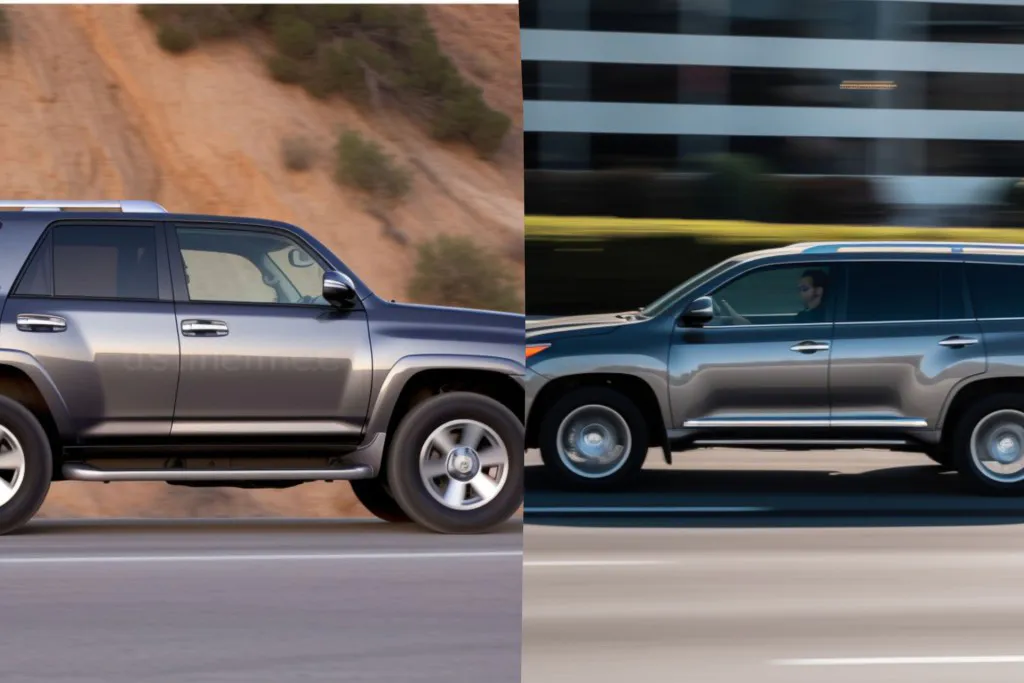Buyers looking for a mid-size SUV have lots to choose from. For those thinking about a Toyota, the 4Runner and Highlander will invariably cross their mind. Yet, while these two vehicles wear the same Toyota badge, they are radically different.
The 4Runner is an old-school body-on-frame SUV that hasn’t seen a significant update in 15 years. At the same time, the Highlander is the benchmark modern family crossover outfitted with advanced technology and numerous comfort and convenience features.
I think of two of my neighbors for this study in contrast. Ken loves his 4Runner, a vehicle he uses for commuting and camping trips. He readily agrees that his Toyota isn’t the most comfortable ride but is willing to trade smoothness for ruggedness and bolder looks. For Ken, the 4Runner is about being different. He wouldn’t be caught dead behind the wheel of a Highlander.
Meanwhile, Rich thinks of his Highlander more as an appliance than a personal statement. He uses his Toyota for everything, including long road trips with the family and their two Golden Retrievers. Ken could care less about how his Highlander looks. He just wants a comfortable ride and is happy he can get more than 30 MPG thanks to a hybrid engine. The all-wheel-drive system comes in handy for the occasional snowstorm.
Putting together this comparison between the 2023 Toyota 4Runner and the 2023 Toyota Highlander made me think a lot of Ken and Rich. Both are satisfied Toyota owners with very different outlooks on cars. These distinctions explain why Toyota still offers the aging but popular 4Runner (the company sold over 120,000 examples in 2022). Sales also speak volumes about the Highlander, with American buyers snapping up more than 220,000 examples in the same period.
Let’s see what makes the 4Runner and Highlander such favored transportation and how they compare. I’ll examine the 2023 model years by looking at pricing, powertrains, ownership costs, safety, features, and warranty coverage.
Learn more about the methodology used for this article.
2023 Toyota 4Runner Vs. Toyota Highlander | A Guide to Trim Levels & Optional Features
Trim Levels: Starting Prices
Quick Take: No matter how you slice it, the 4Runner costs more than the Highlander. Toyota charges a premium for off-road prowess.
New car shoppers looking for a cheap mid-size Toyota SUV may think the long-in-tooth 4Runner offers the least-expensive option. However, that assumption is incorrect. The entry-level Highlander L starts at $36,620 versus $40,155 for the 4Runner SR5, a difference of $3,535.
If base models aren’t your style (like most other buyers), you’ll need to spend $43,105 for a 4Runner TRD Sport or $39,020 for a Highlander LE. These lower trims are separated by $3,995, but it’s worth pointing out that the equipment roster for each vehicle’s respective trims doesn’t align neatly. A 4Runner trim with a TRD label is associated with some degree of extra off-road capability, while the Highlander trims are all about increased levels of comfort and convenience (which also applies to some 4Runner versions).
Looking at the Limited version of both vehicles, the 4Runner sells for $49.390 against $46,275 for the Highlander. The $3,115 separation is less than other trim comparisons, but it’s still consistent. In other words, you will spend $3,000-$4,000 more for a 4Runner than a roughly comparable Highlander.
There’s an even larger amount ($5,145) splitting the 4Runner TRD Pro ($54,620) and the Highlander Platinum ($49,475), but these SUVs serve very different customers. The TRD Pro has off-road capabilities that the Highlander could only dream about, while the Platinum is a luxury ride unobtainable in a 4Runner.
Although the 2023 4Runner doesn’t have a hybrid version, the Highlander does. Like with other of its models, Toyota makes stepping up to better fuel economy quite affordable. The Highlander in hybrid form is only a $1,600 upgrade. The extra cost would pay for itself after 2.5 years (based on driving 15,000 miles per year and spending $3.50 for a gallon of gas).
| 2023 Toyota 4Runner Model | Starting Price |
| SR5 | $40,155 |
| TRD Sport | $43,015 |
| SR5 Premium | $43,215 |
| TRD Off-Road | $44,000 |
| TRD Off-Road Premium | $46,580 |
| 40th Anniversary Special Edition | $47,720 |
| Limited | $49,390 |
| TRD Pro | $54,620 |
| 2023 Toyota Highlander Model | Starting Price |
| L | $36,620 |
| LE | $39,020 |
| XLE | $42,020 |
| XSE | $43,615 |
| Limited | $46,275 |
| Platinum | $49,475 |
| Hybrid LE | $40,620 |
| Hybrid XLE | $43,620 |
| Hybrid Bronze Edition | $46,380 |
| Hybrid Limited | $47,875 |
| Hybrid Platinum | $51,075 |
Cost of Ownership
Quick Take: Over time, the 4Runner is cheaper to own.
Considering long-term ownership costs is a smart approach to new car buying. Edmunds details this for the 2023 4Runner and Highlander.
Based on the base trims with all-wheel drive (non-hybrid for the Highlander), Edmunds projects five-year costs of $56,833 for the 4Runner and $59,191. Owning a Highlander costs $2,358 (or about $472 per year) more, based on 15,000 miles of driving per year. On a per-mile basis, this works out to $0.76 for the 4Runner and $0.79 for the Highlander.
What accounts for the spread? The 4Runner has higher fuel costs, but the Highlander has larger tabs for just about everything else, including depreciation, maintenance, and repairs.
| 5-Year Ownership Cost | ||
| Costs | Toyota 4Runner* | Toyota Highlander* |
| Average Cost Per Mile | $0.76 | $0.79 |
| Depreciation | $13,303 | $19,685 |
| Fuel | $15,077 | $10,685 |
| Maintenance | $5,208 | $5,460 |
| Repairs | $724 | $842 |
2023 | Toyota 4Runner Vs. Toyota Highlander | Specifications | Safety, Interior, and Exterior Features
Sizing up the Toyota 4Runner and Toyota Highlander involves a look at each vehicle’s specifications. Here’s what you need to know.
Vehicle Class & Body Style:
Quick Take: While the 4Runner and Highlander are mid-sized SUVs, the Highlander has a more spacious interior overall.
Although the U.S. Environmental Protection Agency (EPA) designated the 4Runner and Highlander as mid-size SUVs based on passenger volume, the two vehicles have different capacities. The 4Runner has 128 cubic feet of interior space compared to as much as 142 cubic feet for the Highlander.
Later, I’ll cover how this difference translates into passenger and cargo accommodations.
| 2023 Toyota 4Runner | 2023 Toyota Highlander | |
| Class | Mid-Size SUV | Mid-Size SUV |
| 4-Door SUV | SR5, TRD Sport, SR5 Premium, TRD Off-Road, TRD Off-Road Premium, 40th Anniversary Special Edition, Limited, TRD Pro |
L, LE, XLE, XSE, Limited, Platinum, Hybrid LE, Hybrid XLE, Hybrid Bronze Edition, Hybrid Limited, Hybrid Platinum |
Powertrain:
Quick Take: The 4Runner’s fuel economy suffers due to outdated technology, while the Highlander (especially the Hybrid) sips less gas. A new turbocharged base engine in the Highlander offers V6-like performance.
Engine Options & Specifications:
Toyota takes an if-it-ain’t-broke-don’t-fix-it approach with the 4Runner’s engine bay. The venerable 4.0-liter V6 has been a 4Runner powerplant for two decades. In its current form, these six cylinders make 270 horsepower, giving the 4Runner a reasonable 0-60 mph time of 7.7 seconds. I’d call this not too fast and not too slow for a truck.
But the “same old, same old” is not what’s happening under the Highlander’s hood. 2023 marks the departure of the standard V6 in favor of a turbocharged four-cylinder engine (a 2.4-liter unit making 265 horsepower). This powerplant demonstrates what modern technology can do. In particular, turbocharging and other engineering wizardry have given the Highlander V6-like power while delivering better fuel economy.
Acceleration is not the name of the game with the Highlander’s hybrid system. An 8.4-second time for the 0-60 run is pokey, but the trade-off is remarkable fuel economy that’s 40% better than the base engine.
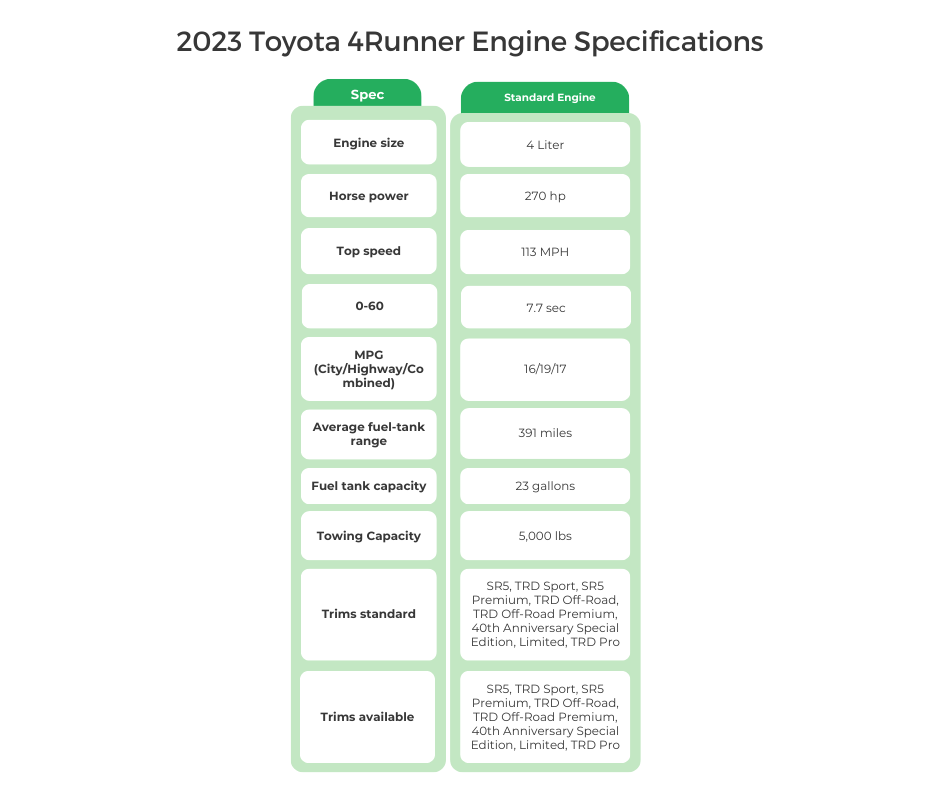
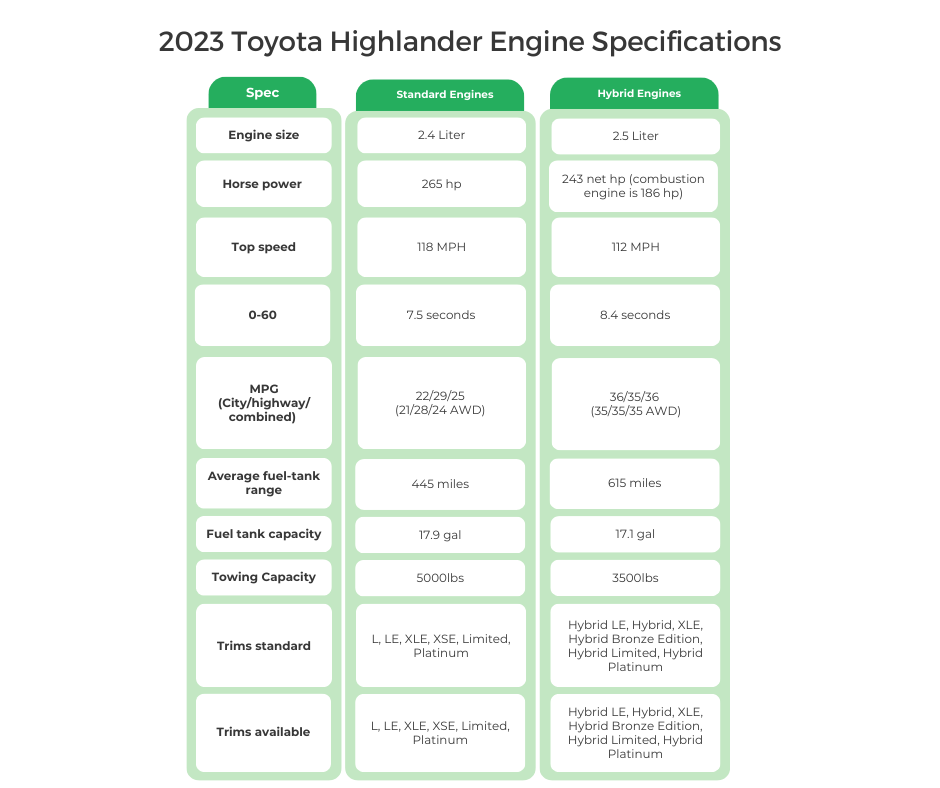
Fuel Economy:
Speaking of fuel economy, the 4Runner’s 16 MPG in the city and 19 MPG on the highway appear prehistoric against even the Highlander with the base engine (22 MPG in the city, 29 MPG on the highway). When Toyota redesigns the 4Runner (anticipated for the 2025 model year), expect four-cylinder engines with turbochargers and hybrid technology for improved MPG performance.
The star of the fuel economy show is the Highland Hybrid, which has a truly impressive EPA rating of 36 MPG in the city and 35 MPG on the highway. As mentioned, a 40% improvement over the base Highlander is notable. Yet a more than 50% improvement over the 4Runner (comparing combined MPG ratings: 17 MPG versus 36 MPG) is remarkable.
The Highlander Hybrid is impossible to beat for someone who doesn’t need the 4Runner’s off-road capability but drives a lot (and needs an SUV).
Transmission Options & Specifications:
Just like with the 4Runner’s engine, there’s one choice for this SUV’s transmission: a five-speed automatic gearbox. This set of gears, like the engine, is ancient and unlikely to find its way into a redesigned 4Runner. In the meantime, this is what buyers have to settle for.
In contrast, the Highlander’s transmission offerings are more sophisticated. Models equipped with the base engine are paired with an eight-speed automatic transmission, which helps fuel economy and acceleration (the more gears, the better in these departments). I’ll also credit Toyota for not switching to a continuously variable transmission (CVT), which is the trend nowadays. A CVT uses a belt system instead of traditional gears to improve fuel economy.
Given the Highlander Hybrid’s mission of sipping as little gas as possible, these versions get an electronic CVT (eCVT).
See the “Tech Talk” section below the charts to learn about CVTs.
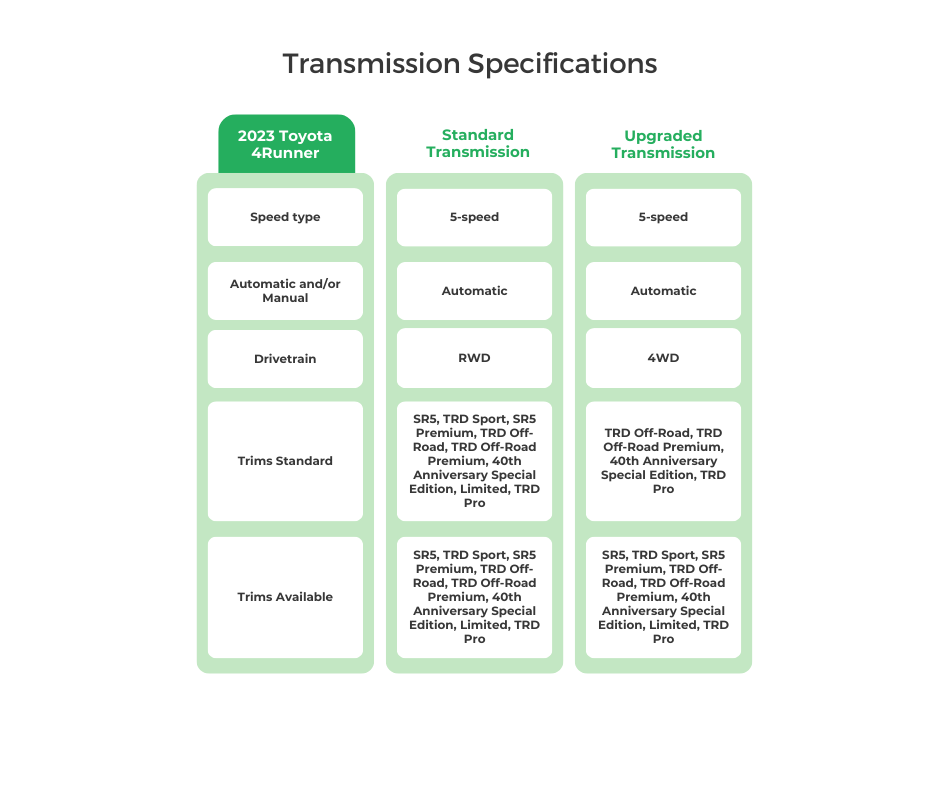
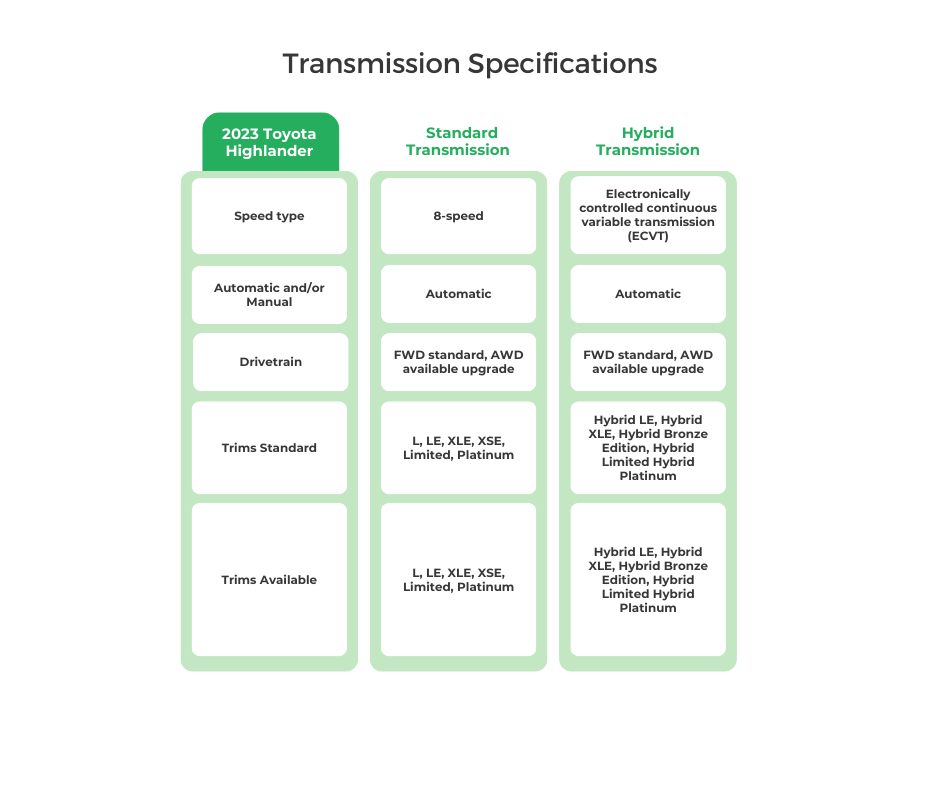
TECH TALK: CVTs
A continuously variable transmission (CVT) does not use gears like a typical automatic transmission. Instead, it has two pulleys connected by a belt. One pulley connects to the engine, and the other connects to the wheels. The belt transfers the power between the pulleys. This setup allows the pulleys to continuously change positions as needed. The CVT automatically adjusts the pulleys as required, providing smooth and efficient power delivery.
Drivetrain:
Toyota uses different systems to handle the spinning of all four wheels. The 4Runner’s four-wheel-drive (4WD) setup locks in equal power to all four wheels for better traction in slippery conditions. Some 4Runners are available with part-time 4WD, which allows drivers to switch between rear-wheel drive (RWD) for regular roads and 4WD for extra traction when needed, like in mud or snow. It gives the option to turn the 4WD locking power on or off. Without 4WD, 4Runners are equipped with RWD.
All-wheel drive (AWD) is an option with the Highlander. This drivetrain automatically transfers power to the wheels with the most grip, which improves handling and traction but isn’t as suited for extreme off-roading. Front-wheel drive (FWD) is the default for Highlanders without AWD.
| 2023 Toyota 4Runner Wheel Drive | FWD | 4WD | RWD |
| SR5 | U | S | |
| TRD Sport | U | S | |
| SR5 Premium | U | S | |
| TRD Off-Road | P | S | |
| TRD Off-Road Premium | P | S | |
| 40th Anniversary Edition | P | S | |
| Limited | U | S | |
| TRD Pro | P | S |
| 2023 Toyota Highlander Wheel Drive | FWD | AWD | RWD |
| L | S | U | |
| LE | S | U | |
| XLE | S | U | |
| XSE | S | U | |
| Limited | S | U | |
| Platinum | S | U | |
| Hybrid LE | S | U | |
| Hybrid XLE | S | U | |
| Hybrid Bronze Edition | S | U | |
| Hybrid Limited | S | U | |
| Hybrid Platinum | S | U |
Safety:
Quick Take: The 4Runner shows its age through lower safety scores, while the Highlander shines, especially in IIHS testing.
NHTSA Safety Ratings
There’s a disparity in how the 2023 4Runner and Highlander stack up in safety testing from the National Highway Traffic Safety Administration (NHTSA). In truth, the 4Runner’s four-star (out of five) rating in overall safety performance and frontal crashes is still respectable. But these results look lacking compared to the Highlander’s perfect five-star ratings. This gap isn’t surprising given the current-generation 4Runner’s design has been around since 2010, which is ancient in the automotive world. On the other hand, the latest Highlander generation is a decade newer and reflects more advanced safety engineering practices.
At the same time, the 4Runner’s three-star rollover ranking comes as no surprise. It’s an old-school body-on-frame truck with a higher ground clearance than the more car-like Highlander. The Highlander’s four-star rollover score is typical of a modern crossover; usually, lower-to-the-ground passenger cars receive a five in this type of testing.
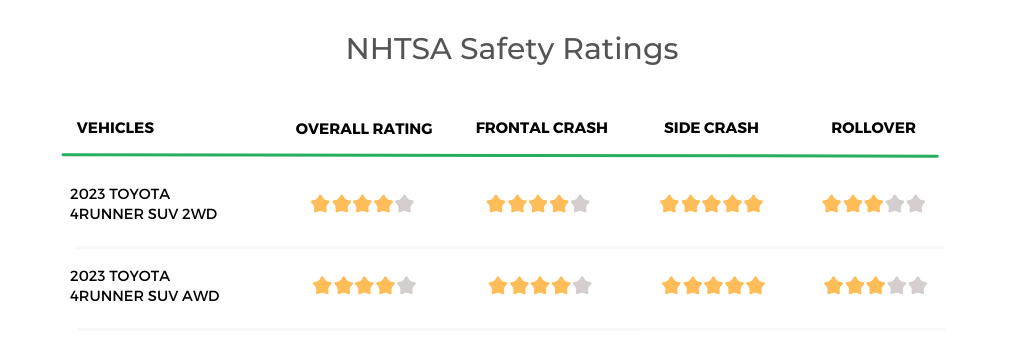
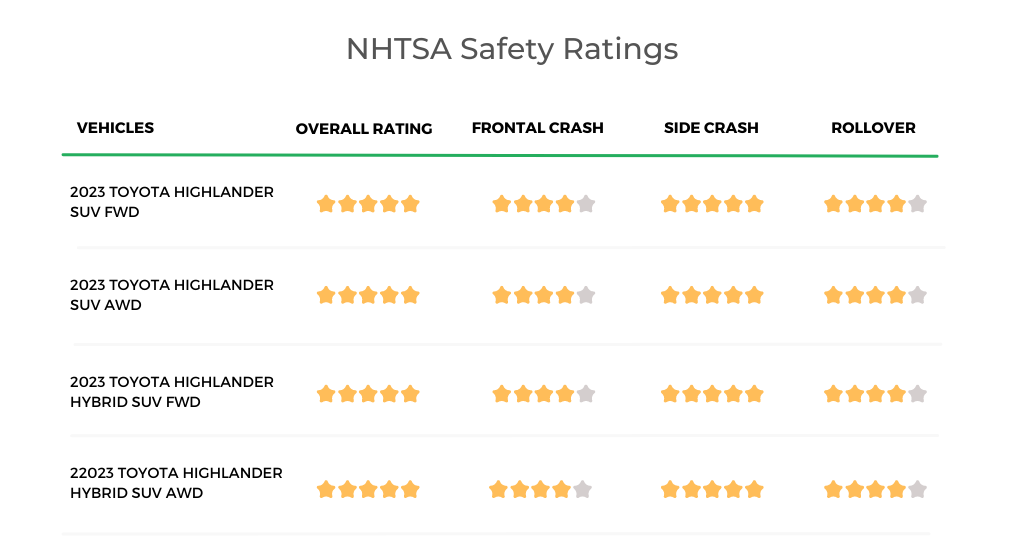
IIHS Awards:
The Insurance Institute for Highway Safety (IIHS) takes a somewhat different approach to safety testing. In particular, it focuses on its small frontal overlap crash test, which the organization feels represents a more real-world scenario (a single car running into a fixed object). IIHS also looks at side impact crashes, roof strength, headlight effectiveness, and advanced driver safety technologies (like automatic emergency braking).
While tested vehicles receive a Good, Acceptable, Marginal, or Poor grade, the true measure comes if a car gets a Top Safety Pick or Top Safety Pick+ designation. If “Good” is a “B” grade, Top Safety Pick notches things up to an “A-,” and the Top Safety Pick+ signifies an “A+.”
The more modern Highlander gets a Top Safety Pick+ designation from IIHS, while the 4Runner fails to receive any of the group’s safety awards.
| IIHS Award | Tested Vehicle | ||
| 2023 Toyota 4Runner |
Midsize SUV/ 4-Door SUV |
None | 2010, 2013, and 2014 Toyota 4Runner SR5 |
| 2023 Toyota Highlander |
Midsize SUV/ 4-Door SUV |
2023 TOP SAFETY PICK + |
2020 Toyota Highlander LE 4-door AWD |
Airbags & Head Restraints:
Airbags are abundant in the 4Runner and Highlander. Both have systems that protect the front row, and side curtain airbags offer all-row protection against a collision or rollover. There’s no news here.
However, the 4Runner has an advantage over the Highlander thanks to knee airbags for both front-row positions. The Highlander only comes with a driver’s knee airbag, which better positions the body in a front-end collision.
In another interesting twist, the 4Runner gets active headrests in the front row. Active headrests (or head restraints) minimize whiplash injuries in certain rear-end collisions. Curiously, the 2023 Highlander doesn’t have this feature.
Neither the 4Runner nor the Highlander comes with overhead airbags. This newer technology replaces traditional front-row units (steering wheel and dashboard) with overhead devices. Active head restraints are usually found in specialty and high-end vehicles to minimize whiplash injuries. Mainstream vehicles like the 4Runner and Highlander aren’t usually equipped with this feature.
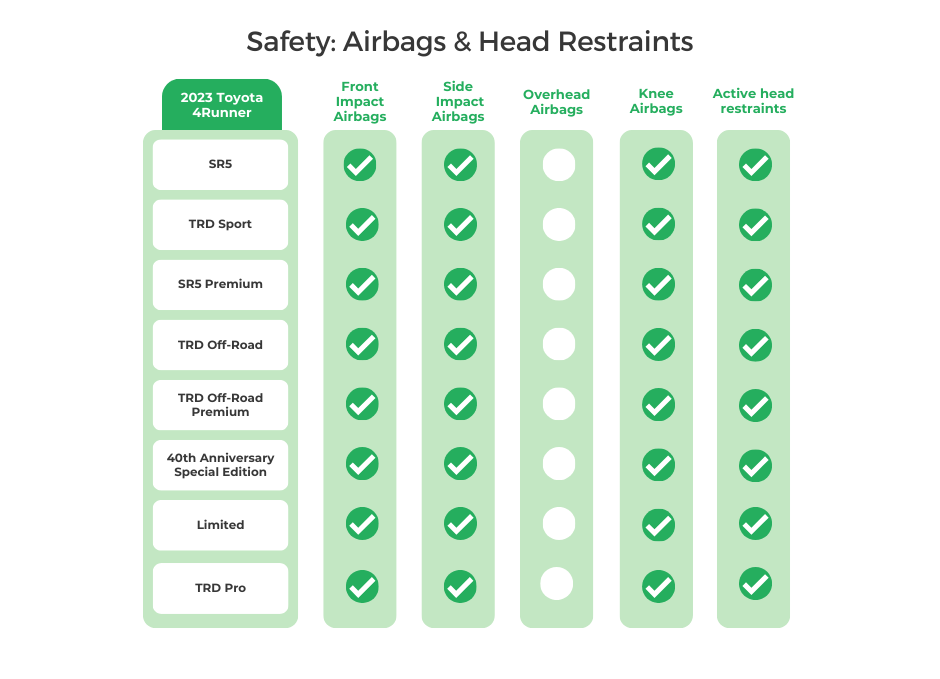
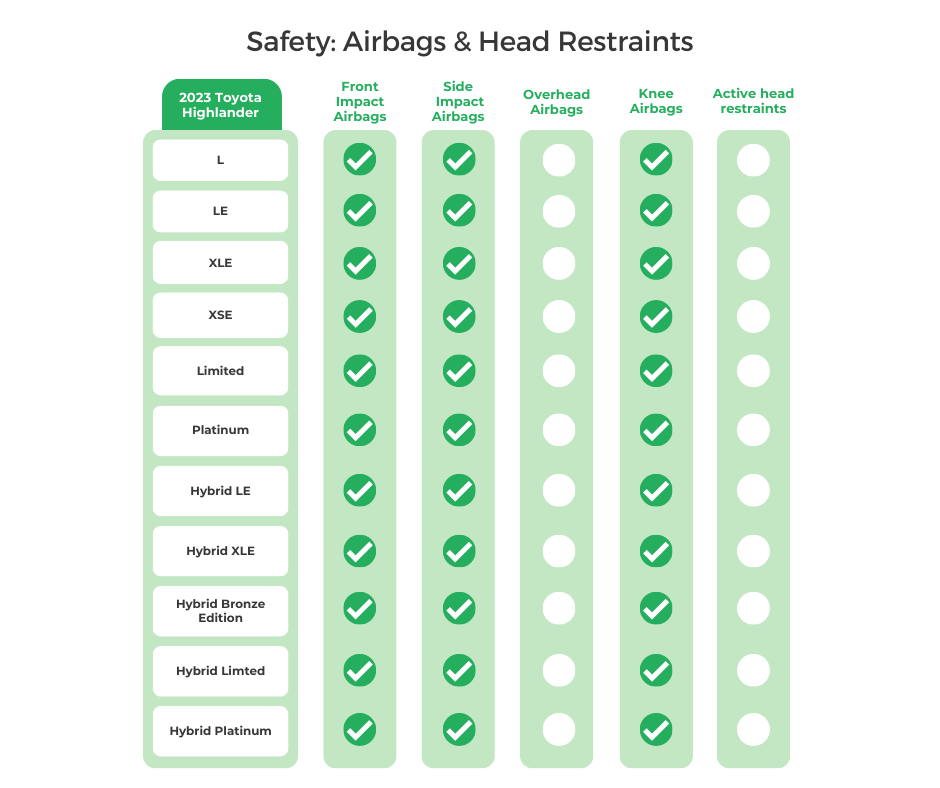
Driver-Focused Features and Equipment:
Quick Take: The 4Runner and Highlander have many driver-assist technologies, but only the Highlander has advanced steering support.
Semi-Autonomous Driving:
If you’re considering getting a car with a hands-free driving system, you’ll need to look beyond the 4Runner or Highlander. These platforms are not known for cutting-edge technology. Adaptive cruise control (ACC), which Toyota calls Dynamic Radar Cruise Control, is about as fancy as it gets for both vehicles. ACC automatically adjusts a vehicle’s speed to maintain a safe distance from cars in front of it and is standard on all 4Runner and Highlander trims
The Highlander goes one step further with steering assist features (included with all trims). Lane tracing assist (with ACC only) helps keep the Highlander center in the lane. There’s also lane departure alert with steering assist that signals if the vehicle is headed outside the lane and gently corrects the steering.
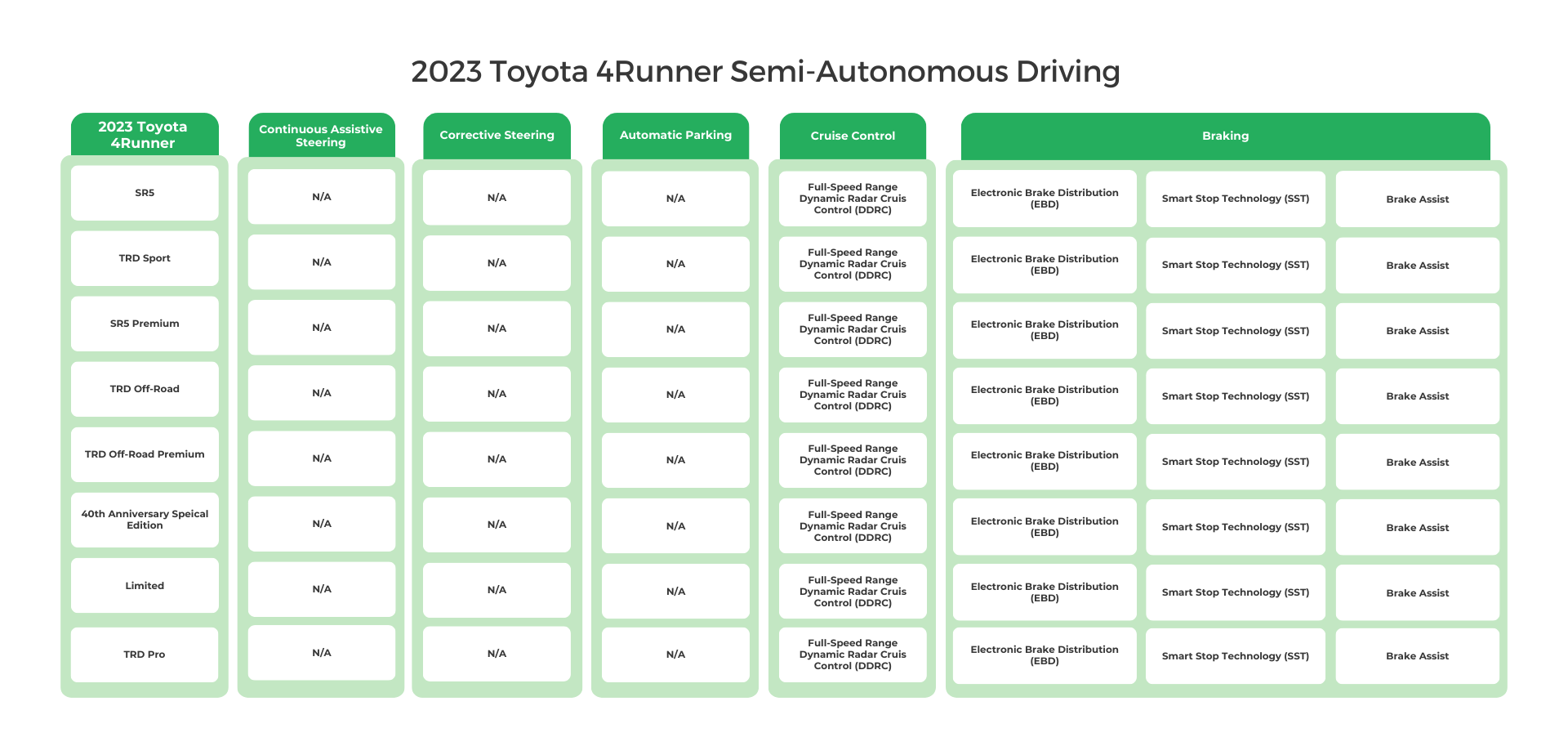
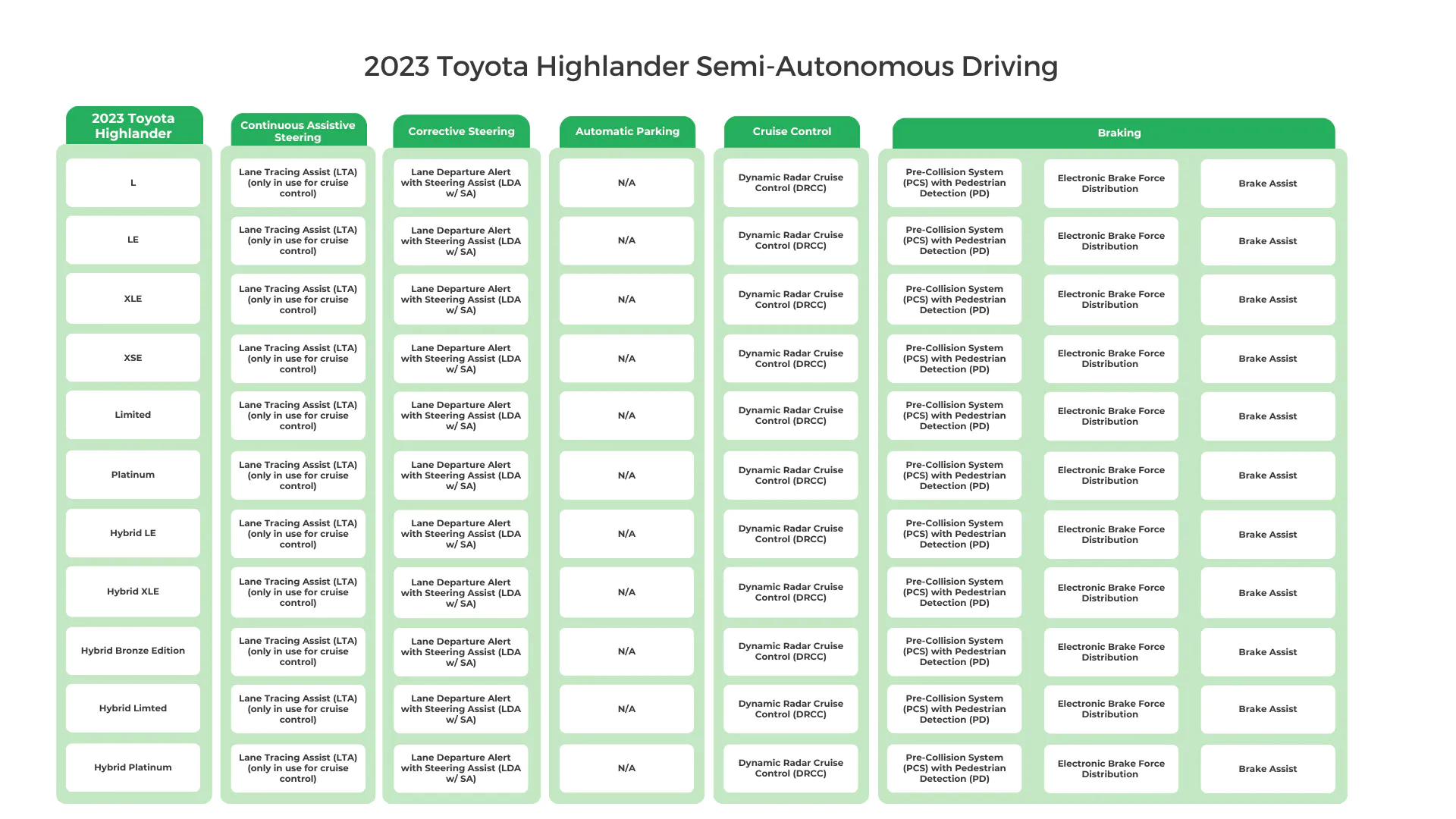
Driver Warning Systems & Telematics:
Advanced driver assistance systems (ADAS) are part of the standard equipment list for the 4Runner and Highlander. All versions have forward collision warning (FCW) and automatic emergency braking (AEB) with pedestrian detection.
At the same time, all 4Runners get two essential features: blind-spot monitoring (BMS) and rear cross-traffic alert (RCTA). BSM and RCTA are standard with all Highlander trims except the L (no BSM/RCTA option exists for the base Highlander).
As mentioned, the Highlander gets a lane departure alert (LDA) system with steering assist. However, the 4Runner gets simpler LDA technology that doesn’t have steering support. Meanwhile, only the Highlander has a rear seat reminder, so no one (like a child) gets left accidentally in the car.
Both vehicles include trial subscriptions for Toyota connected services like emergency help and remote features.
If ADAS technology appears like alphabet soup, check out an effort from AAA, Consumer Reports, J.D. Power, and other groups working to standardize the terminology for these systems.
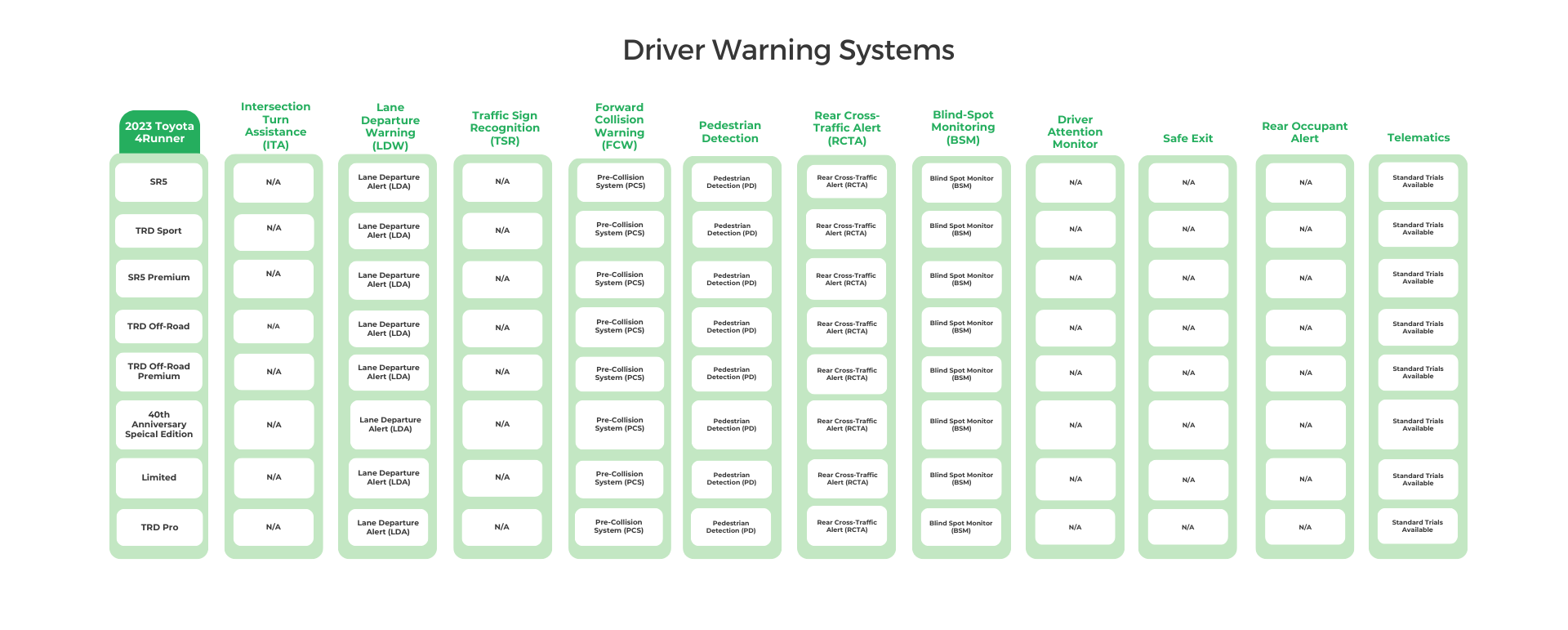
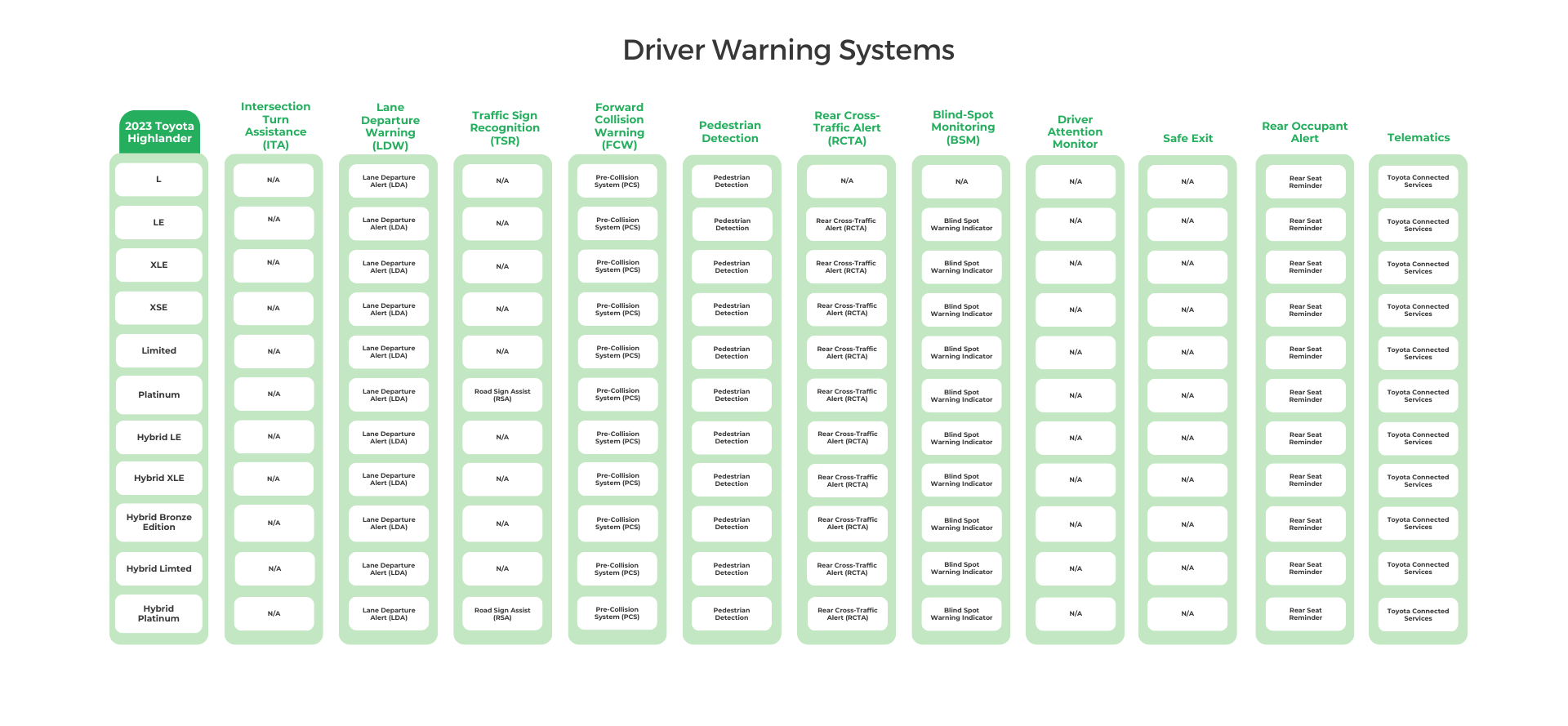
Road Visibility Features:
LED headlights with automatic high beams are pretty much standard on any vehicle costing more than $30,000. The 4Runner and Highlander are no different. They also get a backup camera, which is required under federal regulations.
More advanced visibility features are exclusive to higher-end Highlander trims. These technologies include a head-up display (which displays driver information on the windshield) and adaptive headlights (which direct the light in sync with the front wheels). Some Highlanders also get rain-sensing windshield wipers.
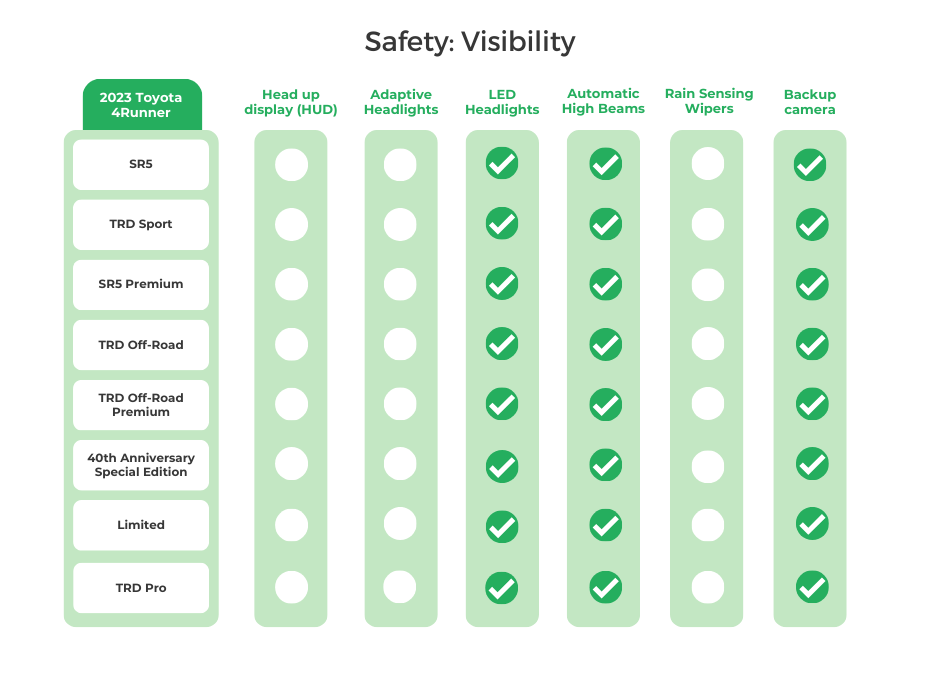
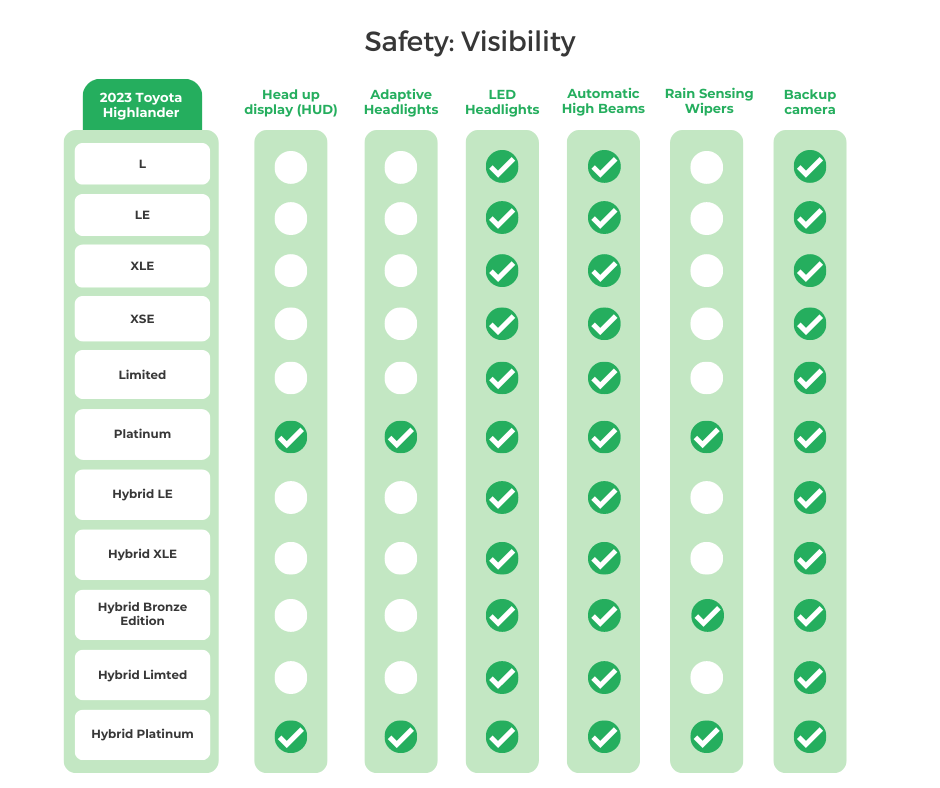
Interior:
Quick Take: The 4Runner and Highlander come standard with Apple CarPlay and Android Auto. Buyers needing heated front seats will want to pick the right 4Runner, as this feature comes standard with all Highlanders. There’s more overall room for passengers and cargo in the Highlander.
Interior Features:
If convenient hands-free cell phone access is a must, you’ll be glad to know that Apple CarPlay and Android Auto are standard with all 2023 4Runner and Highlander versions.
But the same can’t be said about heated front seats. For those needing to stay warm and toasty, this feature only comes on half of the 4Runners trims, while all Highlanders are so equipped.
And speaking of heated seats, some automakers offer this feature through a subscription service. This hasn’t yet happened in the U.S., but in certain countries, BMW offered heated seats for a monthly fee. The advantage is you can shut off the service during warm months, but you’ll need to keep paying (or pay a one-time upfront fee) to activate the heated seats. Recently, BMW announced it was backing away from this practice. Moving forward, the automaker will only charge a subscription for software-based services (like upgraded navigation). Hardware-based features will be part of the vehicle’s initial purchase price.
One industry study shows mixed results for consumer acceptance of features on demand (FoD), with about one-fifth not even being aware of the concept.
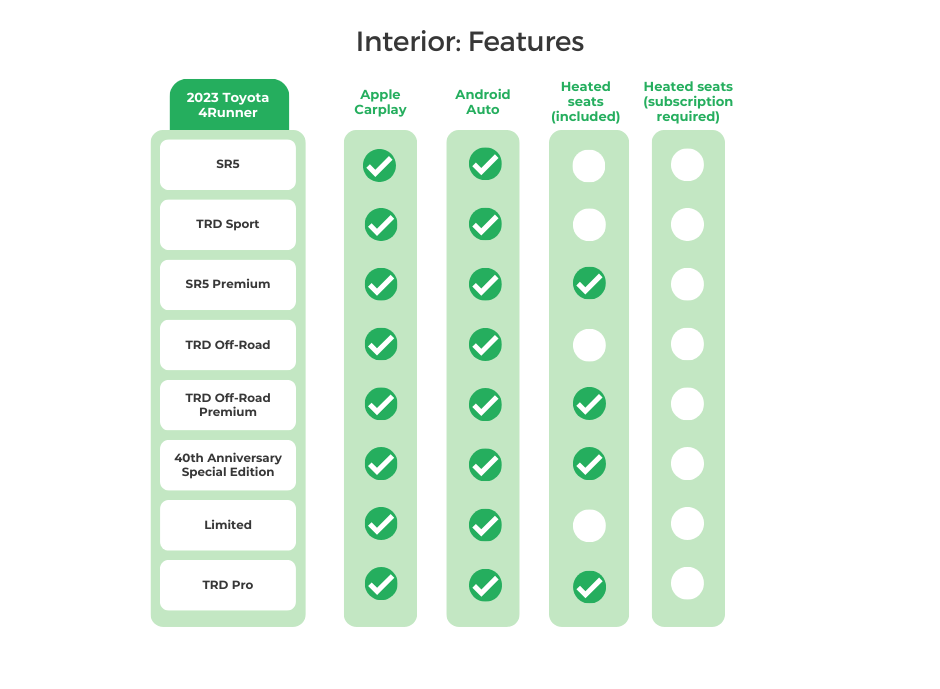

Interior Dimensions:
The Highlander ekes out 0.3 inches more front legroom, but this difference is minor. It’s the second row that really matters, as the Highlander’s 39.0 inches here dominates the 32.9 inches in the 4Runner. In practical terms, it’s like getting stuck in a cheap seat on a low-budget airline versus getting upgraded to a premium spot on a regular carrier.
That said, one of the few measurements where the 4Runner excels is in the third row (which is optional on some 4Runner trims and unavailable on others). But regardless of which vehicle, the 4Runner’s 29.3 inches in the far back seats against 28.0 inches in the Highlander won’t be comfortable for any adult or long-legged teen.
The third-row squeeze play is part of a realization that while these vehicles have extended seating capacity (up to seven for the 4Runner and eight for the Highlander), filling all the rows may not be comfortable for extended trips.
Meanwhile, greater passenger volume (136-142 cubic feet versus 128 cubic feet) helps give the Highlander more space across most interior measurements. Some of the contrast may be marginal, but even a fraction of an inch can make a difference if you’re using every seat.
Regarding cargo space, the 4Runner offers about 4 more cubic feet behind the front row. Meanwhile, the storage area behind the second row tilts to the Highlander’s favor by 1-2 cubic feet (depending on the trim).
The cargo area behind the third row of most mid-size SUVs usually isn’t generous. But the 4Runner’s 9.0 cubic feet here is especially tight compared to the 16.0 cubic feet in the Highlander.
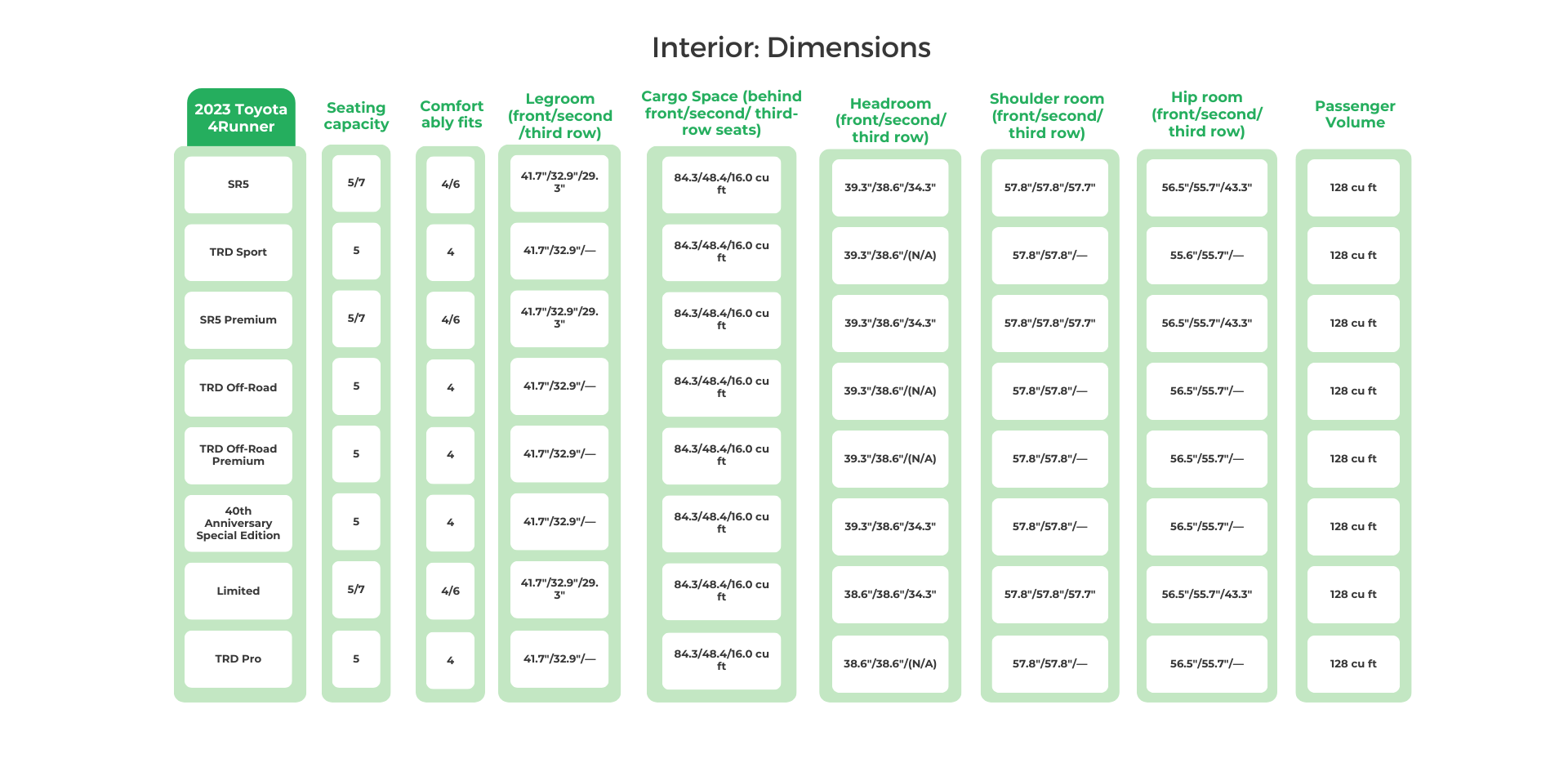
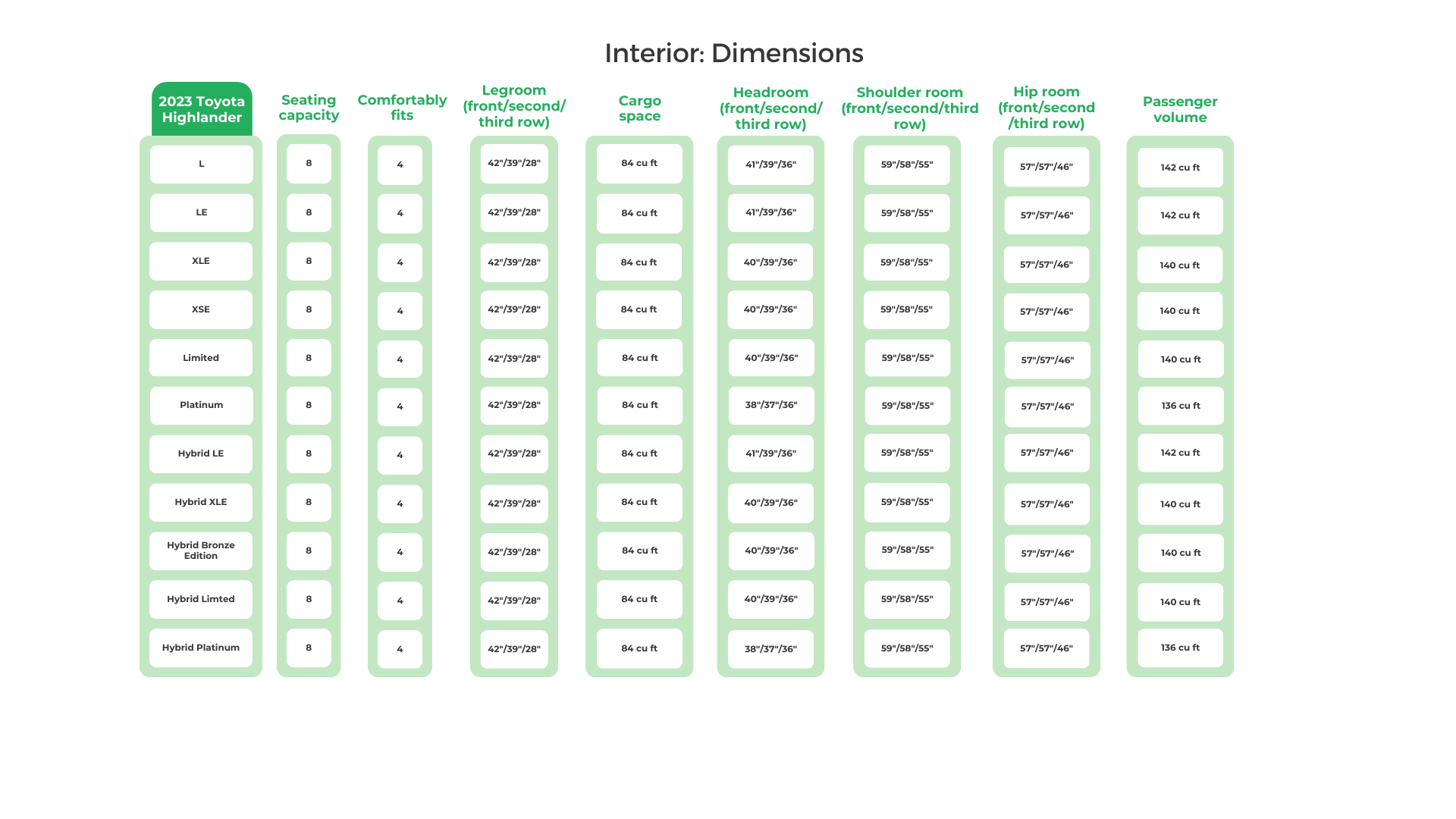
Exterior:
Quick Take: Wild colors are the exclusive domain of the 4Runner. There are pros and cons to differences in exterior measurements for both Toyotas.
Exterior Features:
Wheels may also be an afterthought for many car buyers. But wheel size can impact ride quality. Larger rims can translate into better traction and cornering but may result in a bumpier ride. Bigger wheels also offer better aesthetics by filling out the wheel wells more completely. This is why the higher the trim, the larger the wheel. Different materials (steel or alloy) and finishes also help separate the wheels among the various trim levels.
Like most new cars, the 4Runner and Highlander are available in white, black, gray, or silver. Toyota also spices things up a bit with muted shades of red and blue (there’s a forest green for the Highlander, too). But for more outrageous colors, you’ll need to select a 4Runner in one of two can’t-miss hues: Lime Rush or Solar Octane orange.
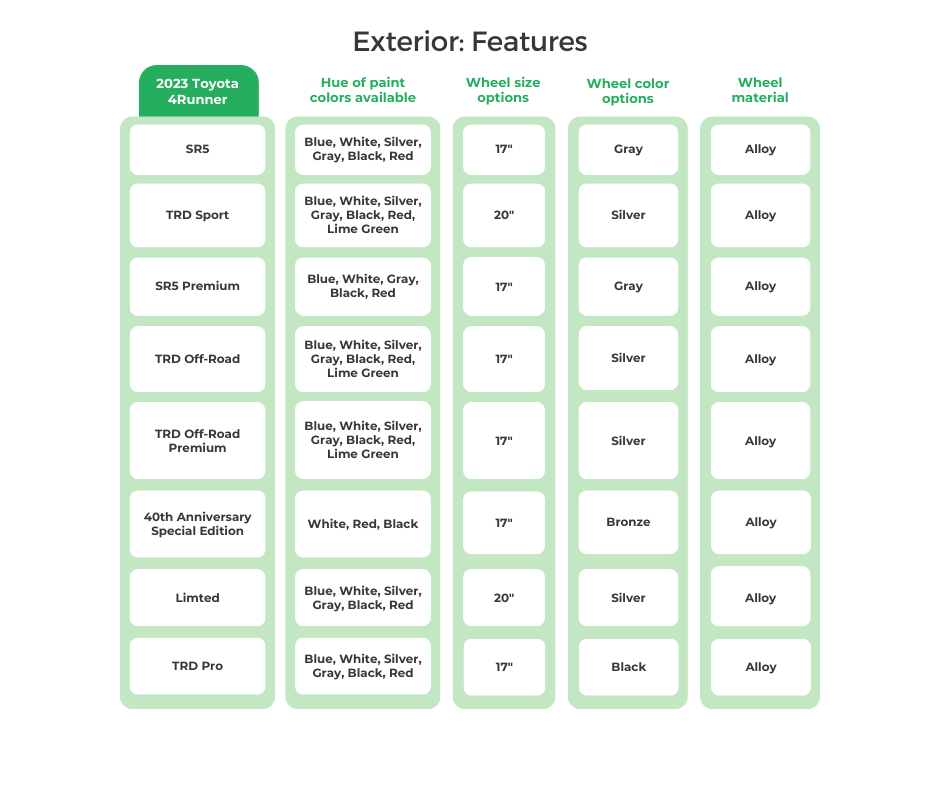
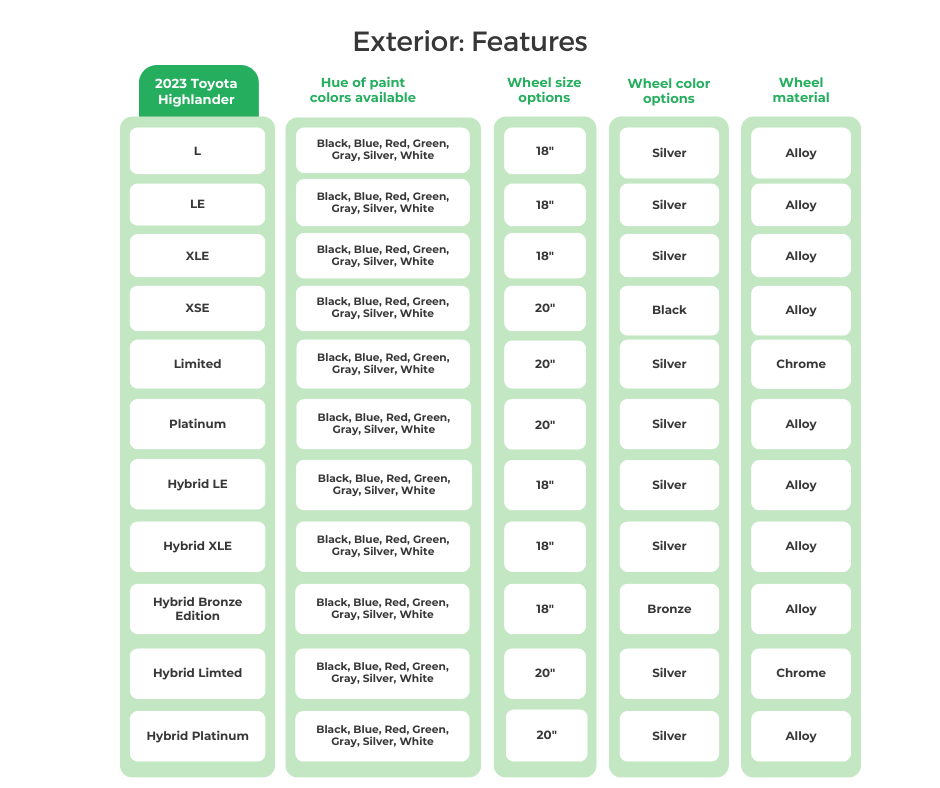
Exterior Dimensions:
You’d be correct if you think the Highlander’s more spacious interior requires a larger exterior. The vehicles have a near-identical width (76.0 inches for the Highlander compared to 75.8 inches with the 4Runner), which won’t matter much in a tight parking situation. However, the Highlander’s extra 3-4 inches of length could make a difference in fitting into a garage.
Some other disparities in exterior measurements could also matter, just not where parking is concerned. The Highlander’s longer wheelbase (2.2 inches more than the 4Runner) helps smooth rough roads and highway expansion strips.
Meanwhile, the 4Runner’s taller ground clearance (1-1.6 inches) can make entry and exit less convenient than the Highlander. However, this extra height helps the 4Runner be better suited for unpaved surfaces.
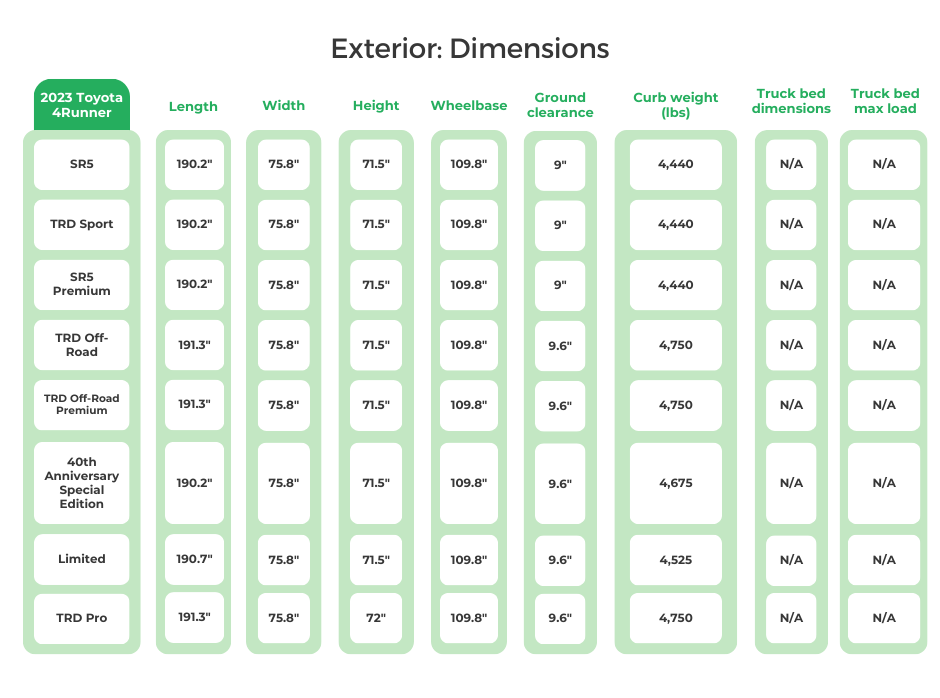

Warranty:
Quick Take: There’s no advantage here. The 4Runner and Highlander enjoy the same Toyota warranty coverage.
It’s logical for the 4Runner and Highlander to have the same factory warranty. Both have bumper-to-bumper coverage for three years or 36,000 miles, and powertrain protection lasts for five years or 60,000 miles. In addition, Toyota covers the traction (hybrid) battery in the Highlander Hybrid for ten years or 150,000 miles.
The automaker also includes scheduled maintenance and roadside assistance for two years or 25,000 miles.
| 2023 Toyota 4Runner Factory Warranty Coverage: |
2023 Toyota Highlander Factory Warranty Coverage: | |
| Basic warranty: | 36 Months/36,000 miles | 36 Months/36,000 miles |
| Powertrain warranty: | 60 Months/60,000 miles | 60 Months/60,000 miles |
| Corrosion perforation warranty: | 60 Months/Unlimited miles | 60 Months/Unlimited miles |
| Air conditioning warranty: | 12 Months/12,000 miles | 12 Months/12,000 miles |
| Hybrid battery warranty: | N/A | 120 months/150,000 miles (Hybrid Battery) |
| Emissions warranty: | Federal: 36 month/36,000 miles (defect), 24 months/24,000 miles (performance) California: 36 months/50,000 miles (performance) |
Federal: 36 month/36,000 miles (defect), 24 months/24,000 miles (performance) California: 36 months/50,000 miles (performance) |
| Roadside assistance coverage: | 24 months/25,000 miles | 24 months/25,000 miles |
| Complimentary schedule service: | 24 months/25,000 miles | 24 months/25,000 miles |
| Total unique recalls: | 1 | 1 (related to driver’s airbag, NHTSA Campaign number: 23V480000) |
Methodology
- Compare two vehicles, Toyota 4Runner and the Toyota Highlander, and provide a comprehensive analysis.
- Gather relevant information and data on both vehicles from reliable sources, such as manufacturer specifications, expert reviews, customer feedback, industry reports, and data sources like manufacturer websites, FIXD App, Kelley Blue Book, FuelEconomy.gov, and NHTSA.
- Collect data on various aspects, including performance, safety features, fuel efficiency, maintenance costs, reliability, owner satisfaction, and market value.
- Identify the key criteria that will be used to evaluate and compare the two vehicles.
- Ensure the criteria cover both objective factors (such as performance metrics, safety ratings, and fuel efficiency) and subjective factors (such as owner satisfaction, comfort, and features).
- Assess the performance of both vehicles based on factors such as acceleration, handling, braking, and overall driving experience.
- Compare engine options, horsepower, torque, transmission options, and any unique performance features.
- Examine the safety features and ratings of both vehicles.
- Evaluate crash test ratings, advanced driver assistance systems (ADAS), active and passive safety features, and any notable recalls or known issues related to safety.
- Consider both NHTSA safety ratings and IIHS awards for a comprehensive safety assessment.
- Analyze the fuel economy of both vehicles based on EPA mileage estimates.
- Compare their MPG ratings, average full-tank range, and any significant differences in fuel efficiency.
- Assess the average annual maintenance and repair costs for both vehicles.
- Consider data from surveyed owners and other reliable sources, such as FIXD App owner surveys, to determine the overall cost of ownership over time.
- Evaluate the reliability of both vehicles based on owner reports, FIXD App data, and any known issues or recalls.
- Consider factors such as engine reliability, common problems by model year, long-term durability, and owner reliability scores gathered from surveys.
- Consider owner satisfaction by gathering information from forums, online communities (Reddit: r/whatcarshouldIbuy), customer reviews, and owner reliability scores.
- Summarize key factors that owners appreciate and any common complaints or drawbacks mentioned by owners.
- Compare the features and technologies offered by both vehicles.
- Highlight any notable differences in terms of infotainment systems, connectivity options, driver assistance features, interior quality, and available upgrades.
- Assess the market value and depreciation of both vehicles.
- Compare average prices, resale value, and how the vehicles hold their value over time.
- Consider average private-seller valuations from Kelley Blue Book (KBB) for a comprehensive assessment.
- Summarize the findings of the comparison, highlighting the positives and negatives of each vehicle.
- Provide a fair and balanced recommendation based on the comparison, considering factors such as budget, personal preferences, specific needs of the buyer, and the comprehensive analysis conducted.
Sources:
- Fuel Economy: Mileage-per-gallon estimates according to the EPA MPG on Fueleconomy.gov.
- Safety Ratings: Crash test data collected and reported by NHTSA, as well as IIHS Award information, were collected for this article.
- Vehicle Prices/Features: Most or all information gathered on vehicle features was from the manufacturer’s website, in this case, toyota.com.

Dave Goldberg is an automotive journalist and lifelong car fanatic. He writes for numerous enthusiast and business outlets and is an ongoing contributor to HotCars.com, one of the most popular car culture websites. When he’s not writing or driving, Dave is either under a hood or asleep. His credentials include a BA in Journalism from The George Washington University.

